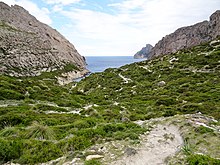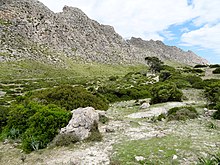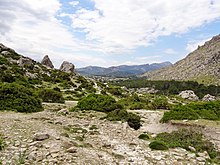Cala Bóquer
| Cala Bóquer beach | ||
|---|---|---|
| location | Pollença municipality | |
| Geographical location | 39 ° 55 '44 " N , 3 ° 5' 41" E | |
|
|
||
| length | 45 m | |
| width | 10 m | |
| nature | pebble | |
| water | clean | |
| Surroundings | natural | |
| tourism | ||
| Visitor frequency | low | |
| Parking spaces | in front of the Cases de Bóquer | |
| monitoring | no | |
| Nudism | Yes | |
| next hospital | Hospital General de Muro (37 km) | |
| next port | Port de Pollensa (5.8 mi / 9.3 km) | |
| Beaches and bays in Mallorca | ||
Cala Bóquer is a small bay with a pebble beach on the northwest coast of the Spanish Balearic island of Mallorca . It is located in the north of the municipality of Pollença on the Formentor peninsula , about 11 kilometers southwest of Cap Formentor . The 45 meter long and 10 meter wide beach of Cala Bóquer is located in a natural environment at the northeast end of the Vall de Bóquer ('Valley of Bóquer').
Location and description
The Vall de Bóquer is part of the 699.47 km² nature reserve of special value (Àrea natural d'especial interès - ANAI) of the Serra de Tramuntana , according to the Natural Area Act (ANAI / ARIP) to protect the soil from construction, and a special bird protection zone (Zona d'especial protecció per a les aus - ZEPA) in accordance with the bird protection directive 79/409 / EEC of the European Union . The closest settlements to the bay are Port de Pollença, 2 kilometers south, and Cala Sant Vicenç, 3.3 kilometers in the southwest, like Cala Bóquer on the northwest coast of the island . The main town of the municipality, the small town of Pollença, is just over 8 kilometers away.
Both the bay and the valley are named after the estate to which they belong. The Cases de Bóquer ('Houses of Bóquer') are located at the south-western entrance to the valley directly above Port de Pollença. The Cala Bóquer is about 1.9 kilometers away from the Cases de Bóquer . The name Bóquer goes back to an earlier Roman settlement, of which only a few remains of the city wall, an entrance gate and ceramics from the 3rd and 4th centuries have survived. Its name is mentioned in various ancient sources as Bocchor, Bocchoris , Bocchorum or civitas Bocchoritana . Among other things, it is mentioned in the Naturalis historia of Pliny the Elder .
The Cala Bóquer stretches about 900 meters into the interior of the island. The bay exit to the open sea is limited by Punta Troneta or Punta de la Sal in the northwest and Es Cingles in the southeast. The foothills of the Serra del Cavall Bernat (up to 362 meters high) and es Morral (up to 353 meters), between which the Vall de Bóquer lies, end at the headlands . The seabed of the bay has a depth of about 2 meters at a distance of 100 meters from the shore, and 3 meters at 150 meters. The beach consists of coarse pebbles and is framed by rocks. A machine gun stand from the Spanish Civil War (1936–1939) has been preserved around 90 meters behind the shoreline of the beach .
At the Cala Bóquer opens Saragall de Cala Bóquer , an approximately 380 meter long Torrent (torrent) which leads only after heavy rain water. It begins at the Fonteta de la Cala at the 85 meter high Coll des Moro pass , the highest point in the Vall de Bóquer . On the southwest side of the Coll des Moro, the Torrent de Bóquer drains the valley towards the Cases de Bóquer and Port de Pollença. There are a few groups of pine trees at the entrance to the valley . Otherwise, the vegetation of the Vall de Bóquer consists mainly of maquis , which extends around the Cala Bóquer almost to the shoreline. There is hardly any vegetation on the beach itself . This is due to the gravel subsoil, which is washed out in stormy seas.
Many wild goats migrate through the valley. The so-called Balearic billy goat (Boc Balear) , also Mallorcan wild goat (Cabra Salvatge Mallorquina) or "fine" goat (Fina) , a sub-form of the domestic goat , is hunted game on Mallorca from September 1st to July 15th . In the seclusion of the Vall de Bóquer home to a large variety of birds, including osprey and bee-eaters , which is why many hobby - ornithologists visit the Valley. The Cala Bóquer is often the destination of hikers, but also private boats and excursion boats. Because of the location in the nature reserve, there are no sunbeds and umbrellas to rent on the beach, as is common on many beaches in Mallorca. There are also no buildings of any kind.
Access
From Port de Pollença you can take Avinguda de Bocchoris to reach a roundabout on the MA-2210 bypass. There is a parking lot north of the roundabout. The signposted hiking trail to the Vall de Bóquer begins there . First you have to cross several gates that belong to the Estate of the Cases de Bóquer . The hiking trail runs right next to the south-western building front of the estate with its fortified tower from the mid-17th century. After turning to the north, the path leads between two rocks into the actual Bóquer valley. As far as the Coll des Moro, it stretches along es Morral on the south-east side of the valley, and then branches down several paths to reach the beach of Cala Bóquer .
literature
- Bartomeu Amengual Gomila: Mallorca's coasts from the air . Detailed and practical travel guide with aerial photos of Mallorca's coasts. 6th edition. Editorial GeoPlaneta, Barcelona 2000, ISBN 84-08-01821-3 , Cala Sant Vicenç, p. 156 (Spanish, original title: Aeroguía del litoral de Mallorca . Translated by Gabriele Grauwinkel and Susanne Pospiech).
- Miguel Ángel Álvarez Alperi: All the beaches of Mallorca . 1st edition. Laluzenpapel, Gijón 2012, ISBN 978-84-938783-1-3 , Cala Bóquer beach, p. 370 (Spanish, original title: Todas las playas de Mallorca . Translated by Meike Schirmeister).
Individual evidence
- ↑ Miguel Ángel Álvarez Alperi: Comprehensive beach guide Mallorca + Cabrera . 1st edition. Ediciones El Cohete, Gijón 2001, ISBN 84-87933-08-4 , Platja Cala Bóquer, p. 233 .
- ^ Islas Baleares - Area Natural de Especial Interés de la Sierra de Tramuntana. www.porlibre.com, archived from the original on November 25, 2013 ; Retrieved June 27, 2013 (Castilian).
- ↑ ES0000073 Costa Brava de Mallorca (LIC, ZEPA). XarxaNatura a les Illes Balears (www.xarxanatura.es), accessed June 27, 2013 (Catalan).
- ↑ DE Woods: OPPIDUM BOCHORITANUM (Puerto de Pollensa) Majorca . In: Richard Stillwell et al. a. (Ed.): The Princeton Encyclopedia of Classical Sites. Princeton University Press, Princeton NJ 1976, ISBN 0-691-03542-3 .
- ↑ Bartomeu Vallori Marquez: Romanos, vándalos y bizantinos: esbozo histórico de unas islas dominadas . Calvià 2011, ISBN 978-84-614-8885-8 , p. 151 ( Online [accessed June 28, 2013]).
- ↑ Enrique García Riaza: La civitas Bocchoritana: una cuestión abierta . In: Revista d'Arqueologia de Ponent . No. 9 , 1999, p. 76 ( online [accessed June 28, 2013]).
- ↑ Pliny the Elder: Naturalis historia . Ed .: Karl Mayhoff . No. 3.34 . Teubner, Leipzig 1906 (Latin, online [accessed June 28, 2013]).
- ↑ Miguel Ángel Álvarez Alperi: All the beaches of Mallorca . 1st edition. Laluzenpapel, 2012, ISBN 978-84-938783-1-3 , Cala Bóquer beach, p. 370 (Spanish, original title: Todas las playas de Mallorca . Translated by Meike Schirmeister).
- ↑ a b Rolf Goetz: Mallorca - Las mejores rutas por la costa y la montaña . 3. Edition. Rother, Munich 2012, ISBN 978-3-7633-4701-8 , Valle de Bóquer, p. 148 ( Online [accessed June 30, 2013] Original title: Mallorca - The most beautiful coastal and mountain hikes . Translated by Mónica Sainz Meister).
- ↑ Senderisme a Mallorca. Consell de Mallorca, accessed June 30, 2013 (interactive map).
- ↑ Tomàs Vibot: The most beautiful bays in Mallorca . 1st edition. El Gall, Pollença 2006, ISBN 978-84-96608-09-2 , Cala Bóquer, p. 38 .
Web links
- Cala Bóquer. Idyllic peace even in high season. Mallorca Magazine , accessed on August 21, 2014 .
- Location of the beach
- Beach description (German)
- Beach description (German)
- Beach description ( Castilian )





